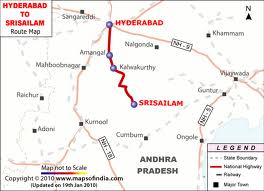The shrine of Lord
Mallikarjuna picturesquely situated on a flat top of Nallamalai Hills,
Srisailam is reputed to be one of the most ancient kshetras in India. It is on
the right side of the River Krishna in Kurnool District of Andhra Pradesh. This
celebrated mountain is also named as Siridhan, Srigiri, Sirigiri, Sriparvatha
and Srinagam. It has been a popular centre of Saivite pilgrimage for centuries.The
prominence of this Divya Kshetram is highlighted by the fact that while
performing our daily household rituals we specify place of location of our
existence with reference to Srisailam.
The shrine of Lord Mallikarjuna picturesquely
situated on a flat top of Nallamalai Hills, Srisailam is reputed to be one of
the most ancient kshetras in India. It is on the right side of the River
Krishna in Kurnool District of Andhra Pradesh. This celebrated mountain is also
named as Siridhan, Srigiri, Sirigiri, Sriparvatha and Srinagam. It has been a
popular centre of Saivite pilgrimage for centuries.
The prominence of this Divya Kshetram is
highlighted by the fact that while performing our daily household rituals we
specify place of location of our existence with reference to Srisailam.
The presiding Deities of this kshetram Lord Mallikarjuna
Swamy is one of the twelve Jyothirlingas and Goddess Bhramaramba Devi is one of
the eighteen Mahasakthis and both are self-manifested. The unique feature of
this kshetram is the combination of Jyothirlingam and Mahasakthi in one campus,
which is very rare and only one of its kind.
There is a common belief in vogue that this Holy
Kshetram exists from times immemorial. The antiquity and origin of God
Mallikarjuna Swamy and Goddess Bhramaramba Devi is not known.The Mallikarjuna Linga is accessible to each and
every devotee and anybody can go into the sanctum sanctorum of Mallikarjuna,
touch him and perform Abhishekam and Archana himself to recitation of Mantras
by Archakas without caste or creed or religion. This clearly reveals that
socialistic pattern of society started from this place and it is still in
existence.
History: Srisailam played a dominant role in our religious, cultural and social history from ancient times.
The epigraphical evidence reveals that the history of Srisailam begins with the Sathavahanas who were the first empire builders in South India. The earliest known historical mention of the Hill - Srisailam, can be traced in Pulumavis Nasik inscription of 1st Century A.D.
The Sathavahanas, the Ikshavakus, the Pallavas, the Vishnukundis, the Chalukyas, the Kakatiyas, the Reedy Kings, the Vijayanagara Emperors and Chatrapathi Shivaji are among the famous emperors who worshipped God Mallikarjuna Swamy.
Prataparudra of Kakatiya Dynasty strived a lot for the improvements of this Kshetram and granted Paraganas for its maintenance. Ganapathideva has spent 12000 Golden Nanyas for the maintenance of the temple.
The period of Reddi Kings is the Golden Age of Srisailam that almost all rulers of the dynasty did celebrated service for this temple. In 14th Century Prolaya Vema Reddi of Reddy Dynasty constructed stepped path-way to Srisailam and Pathalaganga (Here the river Krishna is called as Pathalaganga) and Anavema Reddi constructed Veera Siromandapam in which the Veerasaiva devotees cut off their hands, tongue, limbs with devotion to attain the realisation of the God. This practice is known as Veeracharam.
The Second Harihararaya of Vijayanagara Empire constructed the Mukhamantapam of Swamy shrine and also a Gopuram on Southern Side of the temple.
In the 15th Century Sri Krishnadevaraya Constructed the Rajagopuram on Eastern side and Salumantapas on both sides of the temple.
The last Hindu King who strove hard for the improvement of the temple is Chatrapathi Shivaji who constructed a Gopuram on northern side in the year 1667 A.D.
for more information visit the temple website:www.srisailamtemple.com


No comments:
Post a Comment